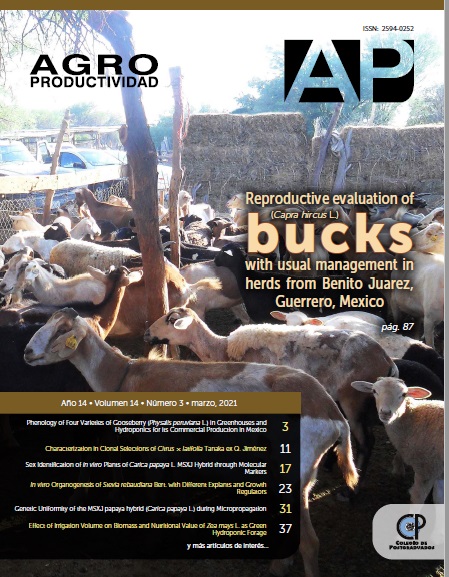Genetic Uniformity of the MSXJ papaya hybrid (Carica papaya L.) during Micropropagation
##plugins.themes.bootstrap3.article.main##
Keywords
In vitro plants, genetic uniformity, papaya, ISSR
Resumen
Objective: To analyze the genetic uniformity of MSXJ hybrid papaya in vitro plants, obtained by direct organogenesis.
Design/Methodology/Approach: The MSXJ papaya hybrid demonstrates quality characteristics for the national and exports market. In vitro culture of plant tissues represents a useful tool for their multiplication and conservation, but somaclonal variation can diminish their genetic and agronomic uniformity. In order to analyze the genetic uniformity of in vitro plants of this hybrid, ten ISSR primers were used for in vitro plants micropropagated during nine subcultures. DNA was extracted using the CTAB method. Data were analyzed using the program PopGene v 1.3.1.
Results: Eighty-five loci of 200 to up to 2000 pb were generated, with 37 polymorphic loci. In the cluster analysis, three groups were observed which separate subculture one, subcultures two to eight, and subculture nine; the Gst value of 0.87 indicated genetic uniformity as far as subculture eight.
Study Limitations/Implications: Papaya is one of the most important tropical fruits worldwide; however, these plants need to be healthy and genetically uniform to guarantee commercial success. In vitro propagation allows obtaining healthy and uniform plants, but it is necessary to study genetic uniformity during their micropropagation.
Findings/Conclusions: The in vitro multiplication of the MSXJ papaya hybrid permitted the regeneration of vigorous plants in 30 d. Molecular profiles indicate that as far as subculture eight, there is genetic uniformity. As such, no more than
eight subcultures are recommended during micropropagation.

